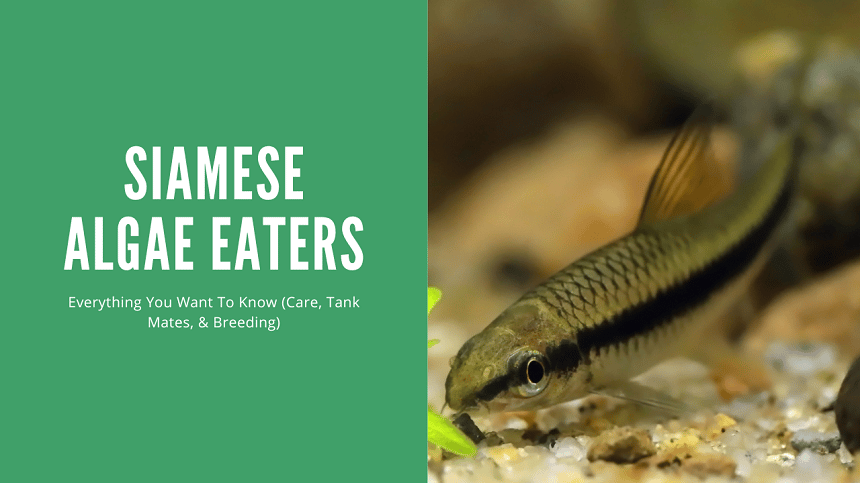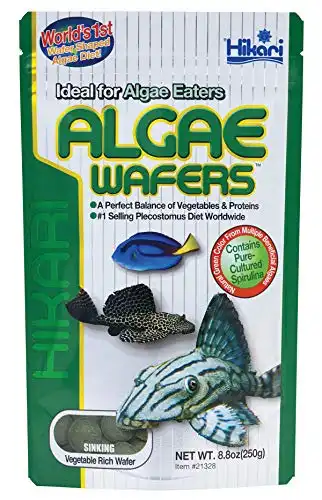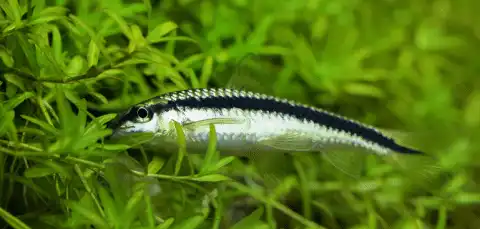Thank you for visiting! By the way… any links on this page that lead to products on Amazon and other stores/partners are affiliate links Aquarium Store Depot earns a commission if you make a purchase.
With a diverse range of variables of algae eating fish introduced to aquariums, choosing a fish that actually fits the role is hard. As someone new to fish-keeping, you will most likely come across algae-related problems such as excessive algae growth. But, don’t worry! Siamese algae eaters have your back.
Famous for their ability to stop algae from intruding on your fish tank, Siamese algae eaters are ideal for adding to your home aquariums. Aside from their tank cleaning abilities, some of their defining characteristics include their calm and friendly nature. Their personality traits make them a peaceful fish species.
Whether you put them with other fish or allow them to keep the freshwater community tank to themselves, handling them is totally hassle-free. Especially, if you are a beginner aquarist.
To get a detailed overview of Siamese algae eaters, stick around till the end of the article.
An Overview of Siamese Algae Eater
| Scientific Name | Crossocheilus oblongus or Crossocheilus siamensis |
| Common Names | Siamese Algae Eater, True Siamese Algae Eater |
| Family | Cyprinidae |
| Origin | Basins of Chao Pharya, Mekong and Malay Peninsula, Southeast Asia |
| Diet | Omnivore |
| Care Level | Easy |
| Activity | Active |
| Lifespan | 10 years |
| Temperament | Peaceful |
| Tank Level | Bottom Dweller |
| Minimum Tank Size | 20 gallons |
| Temperature Range | 75° F to 80° F |
| Water Hardness | 2 to 20 KH |
| pH Range | 6.5 – 8.0 |
| Filtration/Water Flow | Low to moderate |
| Water Type | Freshwater |
| Breeding | Egg layer |
| Difficulty to Breed | Difficult |
| Compatibility | Community tanks |
| OK, for Planted Tanks? | Yes |
What are Siamese Algae Eaters?
Siamese algae eaters, also known as Crossocheilus oblongus or Crossocheilus siamensis, are part of the Cyprinidae family from the order Cypriniformes.
They are bottom-dwellers and have sucker mouths that help them stick to soft surfaces in strong water currents. This common freshwater fish can do wonders to your tank and are easy to deal with, even if they share their tank with other fish.
Experienced aquarists know their worth and understand how suitable they are for the cleaning role. Native to the small rivers and tributaries of Southeast Asia, they are now bred across the world.
And, they proudly hold the title of cleaning down aquariums by consuming all the nuisance algae.
Origin and Habitat
Siamese algae eaters were first sighted in 1823 by natural historians Heinrich Kuhl and Johan Conrad van Hasselt. Their native hometown is Southeast Asia, where you can find them all through Thailand, Chao Phraya, Mekong, Malaysia, and Malay Peninsula.
They live in the rapid waters of the rivers and tributaries of these regions and sometimes appear in flooded forests. The pH level of these flooded areas is low, and the water is hard.
Appearance
A Siamese algae eater is often confused with Siamese Flying Fox because they have some slight physical characteristics in common. However, having a clear perception of their bodily differences may help with the identification.
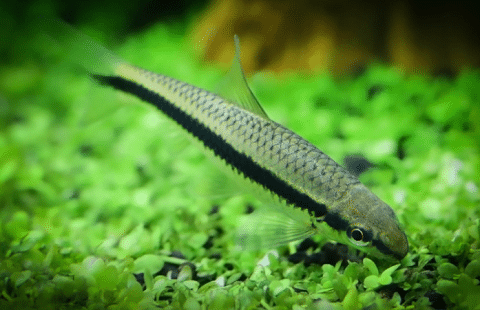
A Siamese algae eater has lemon, bronze, tan, silver, or pale gray body coloring. They can scale their bodies up to 6 inches and have an aerodynamic body shape. But more often than not, they are sold out before they reach the metamorphose phase.
Their torsional body shape helps them to swim through fast water currents, and they almost look like a shark, except for the fact that their bodies are small and they’re not aggressive fish.
A Siamese algae eater has a somewhat upturned snout and a ventrally oriented mouth. Having a sucker mouth serves as a tool using which a Siamese algae eater can stick to smooth surfaces and go with the tide in the wild.
Siamese algae eaters have two small barbels (a whisker-like organ) on their upper lips. These barbels function as detectors and help them mark the presence of tiny prey scampering around the substrate. The barbels present on their upper lips also help them notice any changes in water pressure or any chemical alterations.
Different from other freshwater fish, Siamese algae eaters don’t have a swim bladder. To stay afloat, they have to keep moving in the water. This is probably why you will always find your fish super active in your water tank.
A Siamese algae eater has 6 translucent fins setting out from different locations with its triangle fin the most prominent. The true Siamese algae eater has a pair of pectoral fins, sitting right below the gills, and a pelvic fin on the abdomen, followed by the anal fin that is located between the pelvic fin. And it has a caudal fin at the end of the tail.
Siamese algae eaters have small bodies with a black stripe that runs lengthwise down their bodies, starting from the head and ending at the tail. The black stripe on their bodies offers them protection from predators in the wild and can go dim against the water background.
Sometimes the black stripe on your Siamese algae eater can appear differently when being looked at from a different angle. It might look uneven or slightly rough, but that’s totally fine.
Different Types
Most of the time, it’s really hard to identify types of Siamese algae eaters because they almost look alike. In the aquariums, you might end up buying a different type than what you were actually looking for.
Here are some common types of Siamese algae eaters.
Crossocheilus langei:
Crossocheilus Langei, popular with their more general name, Red Algae Eater. It’s a geek when it comes to cleaning algae off your freshwater tank. One of the easiest ways to identify this type of Siamese algae eater is by looking at their barbels.
Red algae eaters have the longest barbels among other algae eaters of their species and they come in the russet shade. Their abdomens are lighter, and they have a dark streak that runs from their heads to their tails.
Crossocheilus siamensis:
As compared to other fish of this species, the True Siamese Algae Eater is the hardest to find. Crossocheilus siamensis has a silver body with a deep black stripe running from its head to tail. The True Siamese algae eater’s snouts are more pointed and it has a sharp-cornered upper lip.
Crossocheilus oblongus:
This type of Siamese algae eater has a typical-sized body in shades of yellow and brown. The snout is a bit upturned and they have a straight upper lip.
Crossocheilus atrilime:
Crossochelius artilime comes in yellow or bronze shades and consumes moss in larger amounts.
Even though this freshwater specie is also a type of Siamese algae eater who is famous for eating algae, Crossochelius atrilime is more inclined towards gobbling down the moss.
Crossocheilus reticulatus:
Siamese algae eater has another type called Crossochelius Reticulatus or Reticulated Siamese algae eater. This type has brown, yellow, or strong silver color variations, and they lack black stripes on their bodies.
The Difference between a True Siamese Algae Eater and Flying Fox Siamese or Chinese algae eaters
When looking for a Siamese algae eater, you can easily end up buying a Siamese Flying Fox algae eater or a Chinese algae eater. Sometimes, identifying a False Siamese algae eater is hard, too. This usually happens due primarily to the lack of knowledge on the subject that is either from your side or from the store’s side.
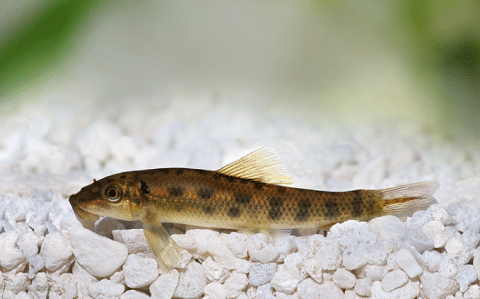
The most noticeable difference between a Siamese algae eater and a flying fox is their fins. Siamese algae eaters have transparent fins, whereas the flying fox has a black bottom and top fins with orange-yellow tints. As for the Chinese algae eater, the stripe on its body is rather craggy.
Another way to work out which fish species you are looking for is by checking for flaps. A Flying Fox has flaps in the corners of its mouth but Siamese algae eaters don’t. Unlike Siamese algae eaters, the black stripe on a Siamese Flying Fox is smoother.
The difference between a Chinese algae eater and a True Siamese algae eater is their growth and behavior. A Chinese algae eater or a Gyrinocheilus aymonieri is quite an aggressive fish. It grows larger than a True Siamese and is poor for home aquariums.
Lifespan
A Siamese algae eater can live up to 10 years in captivity. When in the wild, the chances of their survival for this long period are too low. So, taking care of their diet, aquarium environment, and other key factors is important.
They flourish in freshwater with a temperature ranging from 75° F to 80° F. We will discuss their natural habitat, diet, and other things related to their longevity in more depth in the further parts of the article.
Average Size
The average size of a Siamese algae eater is 6 inches. They take almost 2 years to reach their full length.
Most fishmongers sell them when they are around 2 and a half inches. One type of Siamese algae eater, called Crossocheilus atrilime, is shorter than other types by about an inch.
Care
Handling a Siamese algae eater is totally hassle-free. Their calm, friendly and social nature allows you to have a better aquarium and fish-keeping experience, which you are less likely to have with other fish.
If there’s a list about the benefits of having a Siamese in your tank, then their nature is on the second, if not on the first. This makes them one of the ideal aquarium fish you can have in your community fish aquarium.
Siamese algae eaters thrive in a water temperature that should be above 75° F and below 80° F.
In the wild, they are mostly fed on algae and keep themselves constantly in motion. This, as a result, makes them active fish that need a good-sized aquarium.
They are very less likely to show hostility towards their tank mates. Their chances of going sick are low, too.
However, under certain conditions, your Siamese might show some sickness symptoms. And, to keep these problems at bay, here are some essential things you need to consider before having this algae eater.
Aquarium Setup
The best way to make them feel at home is to set up their aquarium similar to their native residence.
Siamese algae eaters have a natural closeness with rivers and streams of Southeast Asia, where the water is slightly acidic with a low current.
Under the surface, you can find different plants, rocks, and branches where they love wandering around and sometimes hiding. So, while constructing their habitat, make sure they have everything that can make them feel at home.
While they are bottom-dwellers and spend most of their time at the base of the tank, they are quick. That means it is likely that you see them leaping out of the tank and harming themselves. To ensure their safety, keep a lid on the tank or have a hook to avoid any mishap.
Tank Size
The minimum tank requirement for a Siamese algae eater is 20 gallons. You can increase the water amount if you’re going to school with different fish together. For example, add 10 gallons of water per fish.
The Siamese algae eater enjoys swimming around. It might not be into exploring stuff too much, but it stays active and has to remain afloat, and a bigger community fish tank allows it to do that freely.
Also, schooling active fish species with fish species that prefer staying inactive needs a good-sized aquarium. A larger tank will reduce the chances of your Siamese running into their tank mates and disturbing them.
Pro Tip: Avoid housing them in a spherical aquarium. Typically, this type of aquarium is too small and can put them through cramped conditions and different health issues.
Water Parameters
Setting the correct water parameters is more than necessary for their health and well-being. Even though they can survive slightly different water conditions, they still need to be in a freshwater aquarium with water hardness, pH level, and water temperature gauged accurately.
The tropical rivers and streams they are familiar with are acidic and low to moderate flowing. Keep the water temperature above 75° F and below 80° F and water hardness between 2 to 20 KH. The pH level should be 6.5 to 8.0.
Higher levels of disturbed pH can be risky for your freshwater fish.
Filtration and Aeration
Siamese algae eaters produce a lot of waste and therefore they need a strong filtration system. To keep their health problems at bay, they need well-filtrated and fresh water with higher oxygen levels to thrive.
I recommend having a good hang-on-back system or a canister filtration system to filter the water thoroughly. But, make sure whatever type of system you go for, it doesn’t create very strong water currents or waves.
The Pro's Choice
The top choice among professional aquascapers. German engineering and equipped with an intregrated heater.
Lighting
You don’t need any artificial lighting for your freshwater fish tank. Actually, sharp lights can disturb their day-to-day activity.
If they are exposed to bright lights, you might notice them taking refuge in caves or other hiding spots set in the aquarium from the lights.
Aquatic Plants and Decoration
Siamese algae eaters spend most of their time at the base of their tank and hardly travel to the surface. They love hiding spots where they can relax and scavenge for food on the surface. Like other fish, these algae eaters also need some personal space and some time off from their tank mates.
The best way to meet their natural requirements is to decorate your aquarium with dense plants along with creating caves for them.
Plants will keep the water oxygenated and also work as a shelter, and so will the manufactured caves.
Pro Tip: Siamese algae eaters can damage your plants while hunting for food if they are not fed as per their needs. To prevent this from happening, provide them with a good-round diet.
Tank Maintenance
Keeping the fish tank clean is easier than you think, especially when true Siamese algae eaters are involved.
Siamese algae eaters are popular for swallowing down algae, which results in clean plants and fish tanks. But you can still improve their quality of life by following these simple tank cleaning tips.
How to clean the tank?
- Start cleaning off your fish tank by scrubbing the walls with an algae scrapper.
- This is a freshwater species, so make sure that there are no toxic ingredients in any soap used. also avoid any thing that is rusted out.
- After buffing out all the decorative items and aquarium walls, add some fresh water into the tank.
Substrate
Being a bottom-feeding fish, a Siamese algae eater spends most of the time on the ground of the fish tank. Staying at the bottom of the tank and searching for food on the surface can damage their bodies. Their abdomens and frail barbels are most likely to get scratched.
You can prepare a substrate that aligns with the softness of their bodies.
Create the base of the tank with soft sand or smooth aquatic soil. Mix smooth pebbles with it and avoid using any hard rocks or other jaggy material.
Community Tank Mates
Aside from its algae-eating ability, a Siamese eater is an ideal fish to add to the tank because of its nature.
Siamese algae eaters are hardly aggressive and never territorial. They appreciate the company of other fish, act friendly, and love being social. Since they are bottom-dwelling fish, you should focus on what else is with them down there.
Keeping them in groups is completely stress-free. Actually, when you school multiple Siamese algae eaters together, they work as a team and enjoy one another’s company. Not all of them have to be the same species, so you can add other animals who are also algae eaters.
Here’s a list of some great tank mates for your algae eater.
- Bristlenose Plecos
- Corydoras
- Loaches
- Tetras
- Minnows
- Mollies
- Danios
- Platys
- Rosaline Torpedo
- Guppies
- Gold
- Friendly Barbs
- Cherry Shrimp
- Amano Shrimp
- Ghost Shrimp
- Nerite Snails
Poor Tank Mates
Don’t house your algae eater with any large, aggressive, or high territorial fish.
Here are some incompatible tank mates:
Breeding
It’s almost impossible to breed Siamese algae eaters in your aquarium. They are sold in the aquarium trade at an early age. Since the required knowledge on the subject is insufficient.
Another core reason is telling their species apart (video source). They look alike, and many pet store owners have little to no knowledge about their different species. And you can’t really identify them until they are 3 years old.
Interbreeding is possible through artificial means, but a common aquarist can’t do it.
According to some reports, they are bred in fish farms using artificial hormones. These hormones are used to induce spawning and no aquarist can know what methods or hormone therapies do the work.
In the wild, conditions leading them to mate are also unknown. We just know that they travel to the driest part of the streams or rivers to lay their eggs.
So, you can’t replicate those conditions in your aquarium. Like other freshwater fish, slight alterations in water temperature and pH levels might help, but to what extent no one knows yet.
To identify male and female Siamese algae eaters, look at their overall size.
A female Siamese algae eater has a larger abdomen as compared to the male Siamese algae eaters who have somewhat slim bodies. There’s an overall 30% difference in their body size.
Food and Diet
To boost their longevity and improve their overall health and activity, feeding them a balanced diet is mandatory. While in the wild, their diet is fixated on algae, plants, and biofilm, they also consume dead fish or other meaty foods that they come across in their habitat.
Their favorite food is algae, and that’s why they are the most popular freshwater fish in the aquarium trade. But, this is not the only food that they need to survive.
To fend off health issues, they need a mixed diet of protein, fresh vegetables including dead fish, insect larvae, algae wafers, and live plants.
Overfeeding can be an issue because they eat up everything you put in your tank. So, it’s better to feed them a protein-based diet once or twice a week. These aquarium species lack a swim bladder, which means they can easily fall prey to bladder-related problems. To protect them from this, monitor how much they eat.
Some great recommendations for a protein-based diet are bloodworms, brine shrimp, Daphnia eggs, and mosquito larvae. They are bottom-feeding fish, so all the food that you give them should sink into the tank.
You can give them spirulina sinking pellet foods, which are specially made for bottom-dwellers. They can also eat Fish flakes, spinach, broccoli, cucumbers, sinking algae wafers, and live or frozen bloodworms and brine shrimp. You might also see them eating bugs or annoying worms.
Algae wafers are a great way to directly feed your bottom feeding fish. They are especially effective for larger fish like plecos
Most of the time, fish keepers notice them pouncing on aquarium plants. The easiest way to protect your plants is to get them stakes or leaves.
Common Health Problems
Most fish of this species are healthy fish, and they hardly deal with health issues. Still, they might come across some of these common health issues. Some of these diseases happen because of poor tank conditions or overfeeding.
Ich
They are susceptible to Ich, a common disease in fish caused by protozoa.
The symptoms are:
- Rubbing their bodies on different surface spots in the tank
- White spots on body and gills
Bacterial Infections
A bacterial infection happens as a result of some injury. This schooling fish species are very active and might jump out of your tank and injure themselves in the attempt. Antibotics are used to remedy the condition.
- Cloudy eyes
- Tattered fins
- Body patches
- Open sores on the body and mouth
Where to Buy
These fish can be found at most local fish stores. However, if you want to go the online route, I would highly recommend purchasing them from Rob at Flipaquatics. His facility and care are top-notch. Use promo code ASDFLIPPROMO for an extra discount at checkout!
A great algae-eating fish that is known for eating black beard algae. Grows up to 7 inches in length and requires a larger aquarium
FAQs
Do They Eat Algae?
This is probably one of the most important questions. The answer is yes. They eat hair algae or black beard algae and are great at solving any algae problem. Eating black hair algae is one of the hardest tasks to perform, but Red algae eaters can easily do it away.
How Many Can Fit In A 10-gallon tank?
The most straightforward answer is zero. You can’t keep them in a 10-gallon tank, which is too small for their size and other requirements. Keep them in a tank that is at least 20 gallons.
Are They Schooling Fish?
Yes. You can easily put them in a group of 5 or 6. They are not aggressive, but actually super-friendly, calm-tempered, and social.
Can They Live Alone?
Although this fish species enjoys being around other freshwater fish, you can still keep one in your tank. But it’s better to school at least 6 of them together.
What Is The Lifespan Their Lifespan?
Their average lifespan is 10 years, but in some rare cases, they have lived more than that.
Do they attack other fish?
They are friendly and are easy to get along with other fish. To avoid any behavior conflicts, don’t school them with aggressive or semi-aggressive fish.
What Type of Algae Do They Eat?
In their native home, they get several forms of algae. It can be green algae and black beard algae. They help with algae control and make your tanks tidy.
Closing Thoughts
So, if you’re looking for an algae eater that will do well in a community tank and grow to a manageable size, the Siamese algae eater is a great option. Have you kept one of these fish before? Let us know in the comments below!
- About the Author
- Latest Posts
I’m thrilled that you found Aquarium Store Depot! Here you’ll find information on fish, aquariums, and all things aquatics related. I’m a hobbyist (being doing this since I was 11) and here to help other hobbyists thrive with their aquariums! I adhere to a high quality Editorial Process and Review products with real life field usage and practical analysis.

